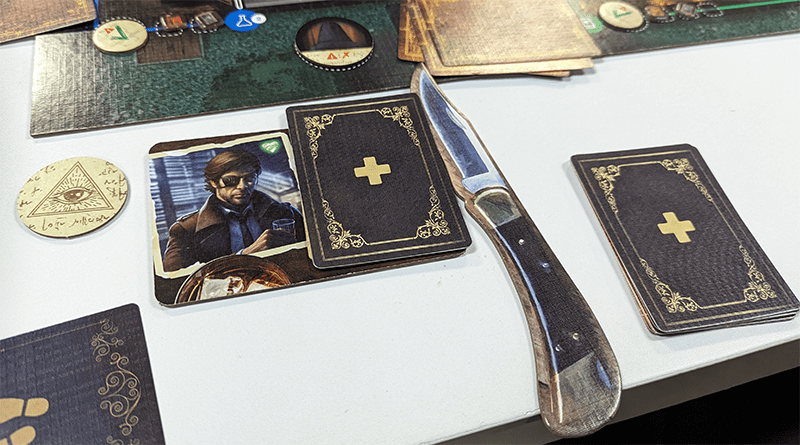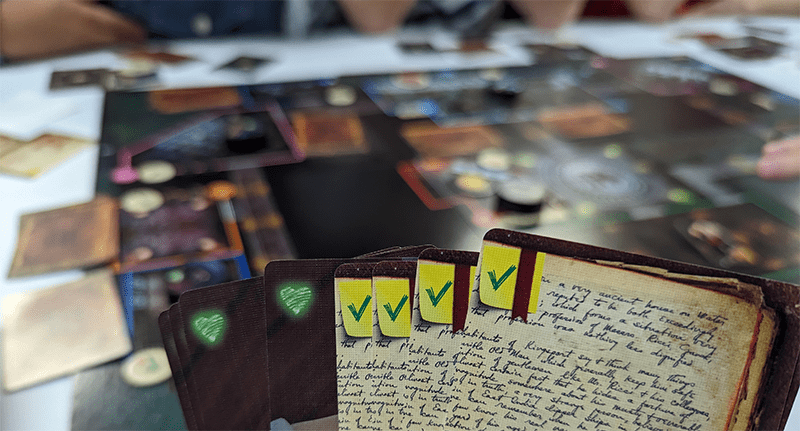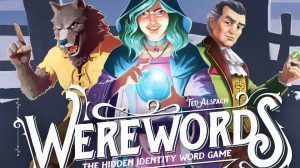Disclosure: Meeple Mountain received a free copy of this product in exchange for an honest, unbiased review. This review is not intended to be an endorsement.
The board game industry loves to fixate on popular trends. Whenever a TV show, movie, or book becomes a breakout hit, publishers quickly push out board games trying to cash in on the craze. For example, The Walking Dead sparked a glut of zombie-themed games for a time. Similarly, Game of Thrones led to many backstabbing political games about scheming nobles. Even entire mechanics and genres will get a spotlight, like social deduction games proliferating after The Resistance grew popular. Which is why I’m so surprised that, despite the highly popular Among Us video game, only one board game attempted to translate that experience into tabletop: the topic of today’s review.
Among Cultists—because subtlety is for the weak—sounds like your typical social deduction game at first glance. The bad team, the cultists in this one, know each other and want to kill the other team or hit the round limit. The good team, the investigators, either want to vote out the cultists or score enough points to win.
Investigators earn points by playing cards to location decks, then flipping those cards over hoping to reveal success symbols. It shares similarities to Among Us – players move their character tokens around a map to colored room spaces as indicated on their route cards to take actions. However, the cultists aren’t bound by route cards and can move more freely. If an investigator reveals enough successes while exploring a room, they score victory points.

Friend or Foe?
So far, this game seems similar to other map-based social deduction titles like Unfathomable or The Thing: Infection at Outpost 31. Players explore a facility, contend with threats, and try to deduce identities. What’s the catch here, Mark? One word: Encounters.
Players have pulse cards that represent their health status – green for alive and red for dead. Investigators start with a hand filled with green pulses, while cultists have a mix. When two players end up alone in the same room, they secretly give one facedown pulse to each other and place it on their character mats, unable to view the card received.
This leads to uncertainty about one’s own state. To resolve it, players need a third opinion – when encountering another investigator later on, they can “check your state” by viewing the hidden pulse cards to confirm if you’re still among the living or have joined the other side. Essentially, players are unable to diagnose themselves and require others to determine their vital status. As a Canadian, this health care system hits too close to home for me.
Unlike most social deduction games, becoming a “ghost” after death in this game still allows players to influence the outcome, similar to Blood on the Clocktower. Deceased players continue hovering around the map as spirits, able to move, communicate, cooperate with their team, and participate in votes. Some character abilities even specifically trigger when a player transforms into a ghost, and they don’t trigger encounters.
That is a basic outline of the game and it’s time we go into more detail about the actual structure. Fortunately, it’s not that hard to explain.
Outwit Eldritch Schemes
Each round starts with movement, proceeding clockwise from the first player. Players publicly discuss optimal paths to minimize dangerous encounters benefiting the cultists. While simple on paper, a good portion of the game’s discussion happens here and is far more involved than you think.
Once movement is done, the event phase begins by simply pulling a token from a bag and doing whatever the event dictates. This involves you looking at a symbol, retreating to the rulebook to understand what it means, and finally doing it. Yes, I will bring this up later.
After resolving encounters, players take turns performing actions. Players can explore rooms by adding success or failure cards to the room deck and revealing them once a room deck has three cards. Success provides progress, while failures stalls or reverse progress. Investigators can only add cards in rooms matching their route cards while Cultists are not restricted. Hallways have one special deck that could potentially spawn cultist or Fishman tokens with a failure reveal, obstructing the Investigators’ progress.

Navigate the Chaos
Crucially, every room begins with at least one card, potentially a failure. The starting Hallway deck also contains one success and one failure. This means a 50% initial chance of spawning enemies when exploring rooms. Understanding these starting conditions highlights the importance of adding more cards to tip the odds favorably.
In essence, Among Cultists is a game centered on information fog-of-war. Each round kicks off with players coordinating movement routes to avoid encounters. As cards gradually fill up room decks and hallways over time, successes and failures accumulate, tilting the scale towards one team. Pointed accusations fly across the table alongside intermittent requests for pulse checks. Votes are called, inviting intricate feints and delicate deceptions. When the killing commences, the cultists aim to artfully disguise the truth while investigators endeavor to pierce the veil of secrecy.
In contrast to social deduction norms, there are quite a few rules in Among Cultists but nothing outlandish. This isn’t as complicated as Unfathomable or Battlestar Galactica yet it isn’t merely a clone of Werewolf or The Resistance either. The designer should pat themselves on the back because they have crafted something unique in a genre oversaturated with simple variations of the original formula. Even though it is unique, it should be easy to teach. Should be.
This rulebook? Evil. It might as well be the Necronomicon because of how incomprehensible it can be at times. A rulebook for a game of this complexity should not warrant me hanging out at the Discord channel for basic inquiries.
Maddening Symbols Over Puzzling Rules
Inquiries such as the cultist’s convoluted victory conditions. In a 6-player or less game, a sole cultist wins by secretly murdering enough investigators over time and can only claim victory at the end of a round. Straightforward enough. However, with 2 cultists, the rules grow opaque. Rather than the cultists ending the game directly, the investigators have to reach their own victory condition. If that’s met, cultists must truthfully admit whether they fulfilled their kill requirement in a prior round – a baffling procedure the publisher later addressed with an official flowchart on their website.
Other rules issues abound. The lightning strike event can trigger building-wide blackouts, enabling encounters with 3+ players in a room – hugely impactful, yet the rules only vaguely state this possibility. Similarly, the Portal event forces players to close a rift within a few rounds but neglects to address key questions around timing near the end of the 10 round limit.
The game touts its icon-based “language independence” to save costs and appeal broadly. However, the impact is that players cannot learn powers easily without translations. And with 11 action choices, the lack of player aids to clarify options proves quite punitive.
Finally, the game has a strict rule forbidding discussion of character abilities. But this gets contradicted by an expansion character called the Snitch which is defined by information sharing!
I could keep going but the point is clear. Among Cultists unfortunately suffers from a deeply flawed rulebook that hampers the onboarding process. The disorganized instructions pose undeniable challenges for new players to understand the gameplay flow. However, if your group can hurdle the obnoxious learning curve, you’ll uncover one of the most engaging and multi-layered hidden identity games in recent memory. The alluring intrigue and cerebral head-games of Among Cultists shine once you get over that initial rulebook roadblock.

Glory Awaits the Determined
Among the game’s most ingenious touches is the route planning during the movement phase. Investigators publicly deliberate over their planned paths across the complex, weighing options and angling for optimal spaces to play cards, encounters, or pulse checks. This collaborative strategic discussion pulls the full group in, as even cultists chime in with fake advice to subtly manipulate the investigators’ movements. It is a system that incentivizes cunning deception from the cultists while demanding sharp pattern recognition from investigators – all through the lens of an extremely simple movement system.
Even the use of the cards in both hallways and rooms deserves praise. It retains the original “success” and “failure” cards of games like The Resistance while spinning it in an interesting direction. With players planting cards in rooms, some information can be traced back. If a room has a lot of failure cards, who has been in that room? Is this the first failure card from a player, or is it one of the starting cards? Questions that will never get a clear answer.
My main gameplay concerns involve player scaling and character powers. With 1 cultist and 6 or fewer players, 2 investigators likely start dead, bringing the cultist dangerously close to their 4 kill victory condition. The modified map layout does inhibit encounters, which partly balances this. However, it feels slightly off-kilter.
Expansions Elevate the Tension
Additionally, the base game powers disappoint in their familiarity. You have standard seers, assassins, and handicap roles that eliminate investigators performing certain actions – nothing fresh for seasoned social deduction fans. The expansions remedy this with intriguing new powers to inhabit, significantly expanding the mechanical possibilities.
I’ve only played the expansions briefly so far, but I will offer some first impressions. They integrate seamlessly while upping the complexity, each with new maps presenting new navigation wrinkles. Elevators and boats serve as mobile rooms, complicating route planning. In the Down into the Abyss expansion, roaming tentacles dynamically block routes alongside thrilling new character powers to exploit. Mountains of Chaos adds a rotating door to the map and one-shot boost abilities that trigger when removing cultist/Fishman tokens – a minor addition that doesn’t massively impact gameplay.
For all its rough edges and perplexing rulebook, Among Cultists undoubtedly stakes its claim as a remarkable social deduction game in recent years. The multi-layered deduction challenges followed by the unique pulse-checking, ever-shifting map routes, and looming encounter threats are all welcome additions to the genre.
If more carefully playtested and edited to ease the rules burden, Among Cultists could have achieved the true masterpiece status it deserves rather than a deeply intriguing curio. In a genre full of copycats, Among Cultists not only curates a unique experience but an excellent one, despite the lack of polish that will likely turn quite a few players off.












Add Comment